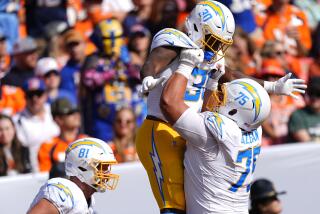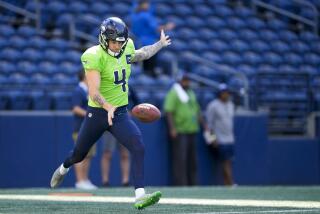Big Britons Learn Football American-Style
- Share via
Mark Cottingham is 6 feet, 5 inches tall and weighs 260 pounds. Lewis Capes is 6-4 and 250.
When bench pressing weights, Cottingham has a best lift of 420 pounds, and Capes has pressed as much as 350. Capes is also a promising shot-putter.
Their massiveness and athletic ability ideally suit them for their tasks as defensive linemen on the Santa Monica College football team.
But that same mass--critical to exploding through blockers and tackling ball carriers--is something of a handicap in rugby, a sport they are much more used to playing. That explains, in part, why they gave up rugby for football.
Cottingham, 19, and Capes, 18, are from England, and both were well-schooled in rugby in their homeland. Both played for prep school teams, Cottingham at Trent College and Capes at Millfield School. Capes says he has also played for Great Britain’s national team.
But both became hooked on American football when highlights of National Football League games were first shown on British television a few years ago. Their interest increased after NFL teams began playing exhibition games at Wembley Stadium in London and the British began forming their own teams to play American football.
And both decided to try their luck at playing football in the United States, each with an eye on a college scholarship and a possible pro career.
Cottingham, who lives in Leicestershire in the Midlands, came here first, arriving late in the summer of 1988 and hoping to enroll at UCLA and take up football. But he arrived after UCLA had closed enrollment for the fall, so he decided to become a student at nearby Santa Monica College.
He was also too late for preseason football training camp, and SMC coaches persuaded him that he would learn more about football from the sidelines. So he was a redshirt last year and learned by watching rather than by trying to get on-the-job training.
Capes, who is from Lincolnshire in eastern England and did not know Cottingham in their homeland, came to SMC last summer after an earlier campus visit with his father Geoff, a professional strongman who was a three-time Olympic shot-putter for Great Britain.
Capes and his father were looking for a school where Lewis could build an athletic career in football and/or track and field. They were introduced to SMC by Frank Cullom, a friend of the family who was the football coach at Venice High School until he retired nearly 20 years ago.
Cottingham, who wrote from California to answer Capes’ queries from England about SMC and American football, is starting at nose tackle for the Corsairs. Capes, who has been with the Corsairs since the start of training camp this year, is a reserve defensive lineman.
Both think they have done the right thing, Cottingham by sitting out a year to learn about the game and Capes by getting into the fray right away.
“If I had played last year,” Cottingham said, “it would have been a waste.” Though there were some things that were familiar to him about football from his experience with rugby, he added, “I had an awful lot to learn.”
“At first, I was the easiest man in the world to trap (block). I used to charge straight down the field because I thought that was my job. I’m slowly picking it up, but I’ve still got a lot to learn.” Cottingham, a dedicated power weightlifter, said that in prep school, as he became more and more interested in American football, he became less and less interested in rugby. He said his rugby coaches believed that “lifting weights slows you down.”
Slow rugby players are not a sought-after commodity. Players, who do not wear protective gear, are required to play the entire 80 minutes of a game and cannot be replaced unless someone is injured. There are only two substitutes available, and if more than two players are incapacitated, an amateur team must play without its full complement of 15.
Cottingham decided that he had more of a future playing football in the United States than as a rugby player back home. “Opportunities out here are greater,” he said. “You can’t go anywhere fast back home.”
He said he worked at summer jobs for three years to save money for his trek to America and that his father, a 6-1, 280-pounder who owns an insulation company, helped out.
He said “football is incredibly explosive,” so that a defensive lineman has to maintain his effort to fight off blockers for only about five or six seconds. “In rugby, you have to pace yourself for a long time.
“The hits in football are harder, more explosive. In rugby, everybody is so tired from running about the field for 10 or 20 minutes at a time” that players are forced to resort to gang tackling rather than trying to bring someone down alone.
If Cottingham has much to learn about football, Capes has much more to master.
SMC Coach Ralph Vidal and his staff wanted Capes to emulate Cottingham and redshirt this year. But Capes resisted, saying, “I have never sat out of anything.”
On the football field, Capes admits: “I don’t know what’s going on around me. I know just enough about what to do to the guy in front of me.” He said he has felt lost when he has played defensive tackle or end and prefers the nose guard position because “you can see what’s going on.”
He said that it was his idea to come to America but that his “dad always backed me up.” That’s a lot of backing, for the Capes are aptly named. Geoff Capes might easily be mistaken for Cape Horn--with Cape Cod thrown in. Lewis said his father is 6-5 1/2 and weighs 26 stone, or 364 pounds.
Lewis said he and his father reason that if he doesn’t make it in football, he still has a good chance to become a top shot-putter. Used to throwing the 14-pound shot as a schoolboy, he tossed the 16-pound shot more than 53 feet in his first attempts.
The Corsairs won their opener, trouncing Chaffey College, 33-3, and Coach Vidal said Cottingham and Capes did well in their first game.
“They are both quality athletes, not just big strong guys,” he said. “It’s really interesting that they have no bad football habits and how easily they can adapt to American football. Their progress is really amazing.”
He said Capes has made a “tremendous jump” from rugby to football, considering that he has had only a few weeks of practice to learn the intricacies of football.
“I hope he’ll be able to help us. Hopefully, we’ll move him around” from one position to another on the defensive line. He said Capes will be a reserve this year and probably “not be able to get to the point where he could start ahead of somebody.”
Because he has been exposed to football for a year longer than Capes, Cottingham is a different story.
He started against Chaffey, and Vidal said: “He played a lot and is a very, very fine football player. I cannot imagine anyone playing his first competitive football game and playing any better.
“He was in on quite a few tackles. Rugby is a non-stop game, and he is used to running and running. He never stops. He has a future; he’s absolutely incredible.”
Vidal then backed off a bit from that estimate, saying he didn’t want to make too much out of Cottingham’s first start because he was “so much bigger and stronger” than Chaffey’s centers. “We’ll really know a lot more about him when he comes up against someone more physical--against bigger, stronger kids.”
Meanwhile, Capes and Cottingham are learning more about football and also about Cottingham’s favorite subject: history. He said it was a revelation to him that American history is taught so differently here than in England.
“Here you call it the Revolutionary War; back home it’s known as a rebellion. I wondered if it was the same history.”
More to Read
Go beyond the scoreboard
Get the latest on L.A.'s teams in the daily Sports Report newsletter.
You may occasionally receive promotional content from the Los Angeles Times.










